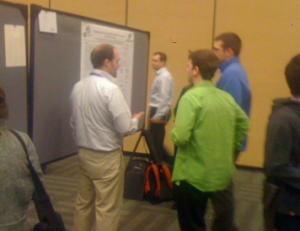Abstract:
The native, folded structure of a protein is known to exhibit limited shelf life while in aqueous solutions. The mechanism for this observed instability may be related to time-dependent aggregation phenomena. Recent investigations into methodologies that increase the conformational stability of proteins involve solubilization of proteins in the presence of ionic liquids (ILs), salts that exist as liquids at or near room temperature. We have explored ILs as a means to increase the shelf life of several proteins. We report herein structural and functional data collected on these proteins in a concentration series of ionic liquids. Utilizing a well-established fluorescence assay to follow the rate of polymerization and depolymerization of actin, it was found that self-association slowed significantly in 1% IL and was not observed in as little as 10% IL. Using circular dichroism, fluorescence, and SAXS we will characterize the relationship between these changes and protein structure.
